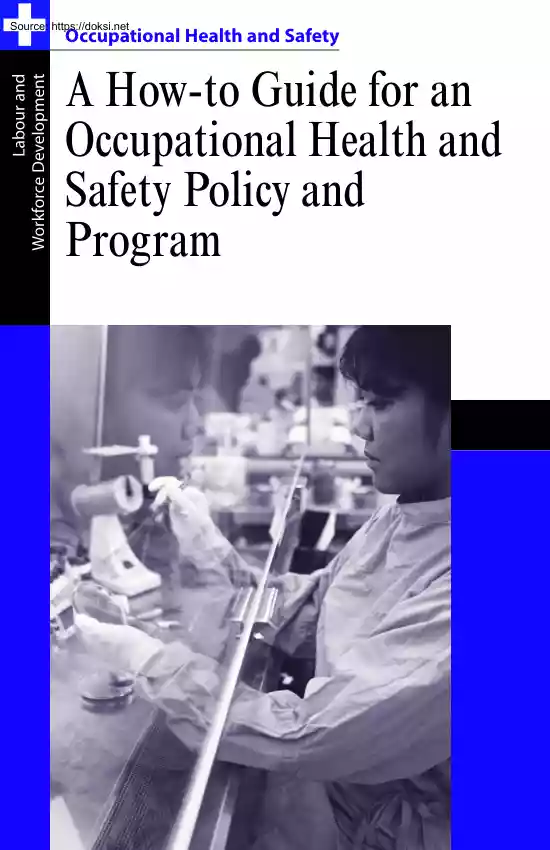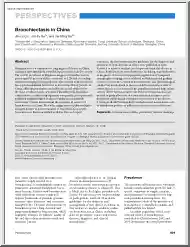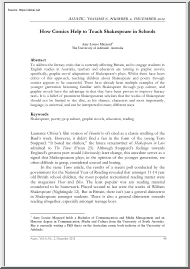A doksi online olvasásához kérlek jelentkezz be!

A doksi online olvasásához kérlek jelentkezz be!
Nincs még értékelés. Legyél Te az első!
Mit olvastak a többiek, ha ezzel végeztek?
Tartalmi kivonat
Labour and Workforce Development Occupational Health and Safety A How-to Guide for an Occupational Health and Safety Policy and Program Introduction This brochure explains two major parts of the Nova Scotia Occupational Health and Safety Act that are important for employers with five or more employees. Employers, contractors, and constructors who regularly employ five or more people must develop an occupational health and safety policy. The first part of this brochure describes policies. An organization regularly employing 20 or more employees must also develop an occupational health and safety program. The second part of this brochure describes occupational health and safety programs. What is an occupational health and safety policy? An occupational health and safety policy is the statement of an employer’s commitment to preventing accidents and illness in the workplace. It describes how the employer and employees can work together to prevent workplace accidents and illness.
The Occupational Health and Safety Act requires that employers with five or more regular employees have an occupational health and safety policy. Why is a policy needed? An Occupational Health and Safety Policy should: • state clearly that the employer is committed to and plans to support accident and illness prevention at work • declare what the employer intends to do to eliminate the causes of accidents and illness • state how the employer will integrate at all levels, the organization’s internal responsibility system in accident and illness prevention • direct human and financial resources to the issues • help achieve the organization’s health and safety objectives. How to write a health and safety policy A policy is a statement of the employer’s commitment to employees’health and safety. Some important points to consider when writing the policy are: • promoting health and safety at work • protecting employees from hazards, such as fire, noise, slips and
falls, violence, and hazardous products • complying with health and safety laws. Policy statements should include: • the employer’s clear commitment to providing a healthy and safe work environment and to integrating health and safety in everyday work activities • the employer’s responsibility to take reasonable precautions to prevent illness and injury. An example is training employees in safe work procedures and supervising and re-enforcing safe work procedures • the responsibility of a senior management person to sign the document and ensure that the policy is carried out • the employer’s commitment to co-operate and consult with all levels of the organization to implement the occupational health and safety policy effectively • everyone’s responsibility in maintaining a healthy and safe workplace • the need to review the policy at least once a year to update it, so that it is current with workplace changes and legislation • the requirement that all
employees be held accountable for their health and safety responsibilities. These references are just suggestions. Your organization may need a broader version. Each organization is unique and local conditions will dictate the specifics of your policy. How should you communicate the policy? The policy should be written in clear language that is easily understood by all employees. The policy must be posted in a prominent area of the workplace and made available on request to an employee or to the Department of Labour and Workforce Development. What does a policy look like? Here is a sample of an occupational health and safety policy. Scope This policy applies to Company/Organization and all of its locations. Policy Company/Organization is committed to providing a healthy and safe work environment for our employees and to integrating that commitment into our everyday activities. This occupational health and safety policy will help us fulfill our commitment. Company/Organization is
responsible for the health and safety of its employees while they are at work. Company/Organization will make every effort to provide a healthy and safe work environment. Managers and supervisors will be trained and held responsible for ensuring that • the employees under their supervision follow this policy • employees use safe work practices and receive adequate training to protect their health and safety • equipment and facilities are safe. Company/Organization, through all levels of management, will cooperate with the Joint Occupational Health and Safety Committee, the Health and Safety Representatives and employees to create a healthy and safe work environment. Cooperation will also be extended to others such as contractors, owners, inspectors, etc. The employees of Company/Organization must support the health and safety policy and must cooperate with the Joint Occupational Health and Safety Committee, the Health and Safety Representatives and others exercising authority
under the applicable laws. It is the duty of each employee to report to the supervisor or manager, as soon as possible, any hazardous conditions, injury, accident, or illness related to the workplace. Also, employees must protect their own health and safety by complying with applicable laws and by following policies, procedures, rules and instructions as prescribed by Company/Organization. Company/Organization will, where possible, eliminate hazards and the need for personal protective equipment. If that is not possible, and where there is a need, employees must use personal protective clothing, equipment, devices, and materials. Company/Organization recognizes the employees’duty to identify hazards and supports and encourages employees to play an active role in identifying hazards and to offer suggestions or ideas to improve health and safety. To ensure that this policy continues to meet our needs, Company/Organization will ensure that our Joint Occupational Health and Safety
Committee, Health and Safety Representatives, and employees review it each year. Signed: President/ CEO/ Owner/ Operator Date What will make the policy work? A key element in making sure your occupational health and safety policy works in your organization is to involve everyone in the process. That means your policy is drafted with input from all levels of the company. Also, your policy should be flexible enough to adapt to the needs of diverse company applications. To make implementation of your policy easier, make sure that: • everyone in the workplace knows about your policy • everyone understands their roles and responsibilities • accountability is clearly established • adequate human and financial resources are provided • a process for setting up and reviewing procedures and programs is established. What is a program? An organization’s occupational health and safety program contains the elements that make it possible to realize its policy objectives. Each program
will be unique to the company that develops it, but some elements are needed to make them comply with the laws and to meet general health and safety standards. What must a program contain? An occupational health and safety program must have: • a method to ensure that employees are trained on how to protect themselves when dealing with hazardous materials or situations and that the employees are supervised • a method to establish and write safe work procedures and to make sure that employees use them • a description of how a Joint Occupational Health and Safety Committee and the Health and Safety Representatives fit within the program. The program must outline how the committee and the representatives gain access to a manager with adequate authority to address health and safety issues • a system for identifying hazards, including: • evaluating/ inspecting the work areas regularly • a reporting method, with someone given the job of ensuring that the issues are addressed •
a clear idea of what, when, and how the employer will report to the committee or representative about workplace hazards • a monitoring, follow-up, and control system for hazards that may be identified in the workplace • a system to keep all records concerning health and safety and any reports of inspections or orders written by the Department of Labour and Workforce Development, or tests performed on the workplace. • a method for monitoring the implementation and effectiveness of the program. Workplace Safety and Insurance System In Nova Scotia the partners in the Workplace Safety and Insurance System include workers, employers, the Workers’Advisers Program, the Workers’ Compensation Appeals Tribunal, the Occupational Health and Safety Division and the Workers’ Compensation Board, and others who provide service in the System. For information on the System, the government partners and the services we provide visit our website at <www.wsisnsca> This information
has been prepared by the Occupational Health and Safety Division. For clarification on the material or any other parts of the Occupational Health and Safety Act or Regulations, please contact us at: Occupational Health and Safety Division Nova Scotia Department of Labour and Workforce Development P.O Box 697 Halifax, NS B3J 2T8 Telephone: (902) 424-5400 (Halifax area only) Toll-free: (800) 952-2687 (NS only) Fax: (902) 424-5640 Website: www.govnsca/lwd/healthandsafety Additional information on the preparation of a policy and program is available from the Workers’ Compensation Board of Nova Scotia and can be accessed at: Workers’ Compensation Board of Nova Scotia 5668 South Street Halifax, NS B3J 2Y2 Main Office (Halifax) Telephone: (902) 491-8999 (Halifax area) Toll free: (800) 870-3331 (NS only) Website: www.wcbnsca/ Labour and Workforce Development Occupational Health and Safety
The Occupational Health and Safety Act requires that employers with five or more regular employees have an occupational health and safety policy. Why is a policy needed? An Occupational Health and Safety Policy should: • state clearly that the employer is committed to and plans to support accident and illness prevention at work • declare what the employer intends to do to eliminate the causes of accidents and illness • state how the employer will integrate at all levels, the organization’s internal responsibility system in accident and illness prevention • direct human and financial resources to the issues • help achieve the organization’s health and safety objectives. How to write a health and safety policy A policy is a statement of the employer’s commitment to employees’health and safety. Some important points to consider when writing the policy are: • promoting health and safety at work • protecting employees from hazards, such as fire, noise, slips and
falls, violence, and hazardous products • complying with health and safety laws. Policy statements should include: • the employer’s clear commitment to providing a healthy and safe work environment and to integrating health and safety in everyday work activities • the employer’s responsibility to take reasonable precautions to prevent illness and injury. An example is training employees in safe work procedures and supervising and re-enforcing safe work procedures • the responsibility of a senior management person to sign the document and ensure that the policy is carried out • the employer’s commitment to co-operate and consult with all levels of the organization to implement the occupational health and safety policy effectively • everyone’s responsibility in maintaining a healthy and safe workplace • the need to review the policy at least once a year to update it, so that it is current with workplace changes and legislation • the requirement that all
employees be held accountable for their health and safety responsibilities. These references are just suggestions. Your organization may need a broader version. Each organization is unique and local conditions will dictate the specifics of your policy. How should you communicate the policy? The policy should be written in clear language that is easily understood by all employees. The policy must be posted in a prominent area of the workplace and made available on request to an employee or to the Department of Labour and Workforce Development. What does a policy look like? Here is a sample of an occupational health and safety policy. Scope This policy applies to Company/Organization and all of its locations. Policy Company/Organization is committed to providing a healthy and safe work environment for our employees and to integrating that commitment into our everyday activities. This occupational health and safety policy will help us fulfill our commitment. Company/Organization is
responsible for the health and safety of its employees while they are at work. Company/Organization will make every effort to provide a healthy and safe work environment. Managers and supervisors will be trained and held responsible for ensuring that • the employees under their supervision follow this policy • employees use safe work practices and receive adequate training to protect their health and safety • equipment and facilities are safe. Company/Organization, through all levels of management, will cooperate with the Joint Occupational Health and Safety Committee, the Health and Safety Representatives and employees to create a healthy and safe work environment. Cooperation will also be extended to others such as contractors, owners, inspectors, etc. The employees of Company/Organization must support the health and safety policy and must cooperate with the Joint Occupational Health and Safety Committee, the Health and Safety Representatives and others exercising authority
under the applicable laws. It is the duty of each employee to report to the supervisor or manager, as soon as possible, any hazardous conditions, injury, accident, or illness related to the workplace. Also, employees must protect their own health and safety by complying with applicable laws and by following policies, procedures, rules and instructions as prescribed by Company/Organization. Company/Organization will, where possible, eliminate hazards and the need for personal protective equipment. If that is not possible, and where there is a need, employees must use personal protective clothing, equipment, devices, and materials. Company/Organization recognizes the employees’duty to identify hazards and supports and encourages employees to play an active role in identifying hazards and to offer suggestions or ideas to improve health and safety. To ensure that this policy continues to meet our needs, Company/Organization will ensure that our Joint Occupational Health and Safety
Committee, Health and Safety Representatives, and employees review it each year. Signed: President/ CEO/ Owner/ Operator Date What will make the policy work? A key element in making sure your occupational health and safety policy works in your organization is to involve everyone in the process. That means your policy is drafted with input from all levels of the company. Also, your policy should be flexible enough to adapt to the needs of diverse company applications. To make implementation of your policy easier, make sure that: • everyone in the workplace knows about your policy • everyone understands their roles and responsibilities • accountability is clearly established • adequate human and financial resources are provided • a process for setting up and reviewing procedures and programs is established. What is a program? An organization’s occupational health and safety program contains the elements that make it possible to realize its policy objectives. Each program
will be unique to the company that develops it, but some elements are needed to make them comply with the laws and to meet general health and safety standards. What must a program contain? An occupational health and safety program must have: • a method to ensure that employees are trained on how to protect themselves when dealing with hazardous materials or situations and that the employees are supervised • a method to establish and write safe work procedures and to make sure that employees use them • a description of how a Joint Occupational Health and Safety Committee and the Health and Safety Representatives fit within the program. The program must outline how the committee and the representatives gain access to a manager with adequate authority to address health and safety issues • a system for identifying hazards, including: • evaluating/ inspecting the work areas regularly • a reporting method, with someone given the job of ensuring that the issues are addressed •
a clear idea of what, when, and how the employer will report to the committee or representative about workplace hazards • a monitoring, follow-up, and control system for hazards that may be identified in the workplace • a system to keep all records concerning health and safety and any reports of inspections or orders written by the Department of Labour and Workforce Development, or tests performed on the workplace. • a method for monitoring the implementation and effectiveness of the program. Workplace Safety and Insurance System In Nova Scotia the partners in the Workplace Safety and Insurance System include workers, employers, the Workers’Advisers Program, the Workers’ Compensation Appeals Tribunal, the Occupational Health and Safety Division and the Workers’ Compensation Board, and others who provide service in the System. For information on the System, the government partners and the services we provide visit our website at <www.wsisnsca> This information
has been prepared by the Occupational Health and Safety Division. For clarification on the material or any other parts of the Occupational Health and Safety Act or Regulations, please contact us at: Occupational Health and Safety Division Nova Scotia Department of Labour and Workforce Development P.O Box 697 Halifax, NS B3J 2T8 Telephone: (902) 424-5400 (Halifax area only) Toll-free: (800) 952-2687 (NS only) Fax: (902) 424-5640 Website: www.govnsca/lwd/healthandsafety Additional information on the preparation of a policy and program is available from the Workers’ Compensation Board of Nova Scotia and can be accessed at: Workers’ Compensation Board of Nova Scotia 5668 South Street Halifax, NS B3J 2Y2 Main Office (Halifax) Telephone: (902) 491-8999 (Halifax area) Toll free: (800) 870-3331 (NS only) Website: www.wcbnsca/ Labour and Workforce Development Occupational Health and Safety




 Ahogy közeledik a történelem érettségi, sokan döbbennek rá, hogy nem készültek fel eléggé az esszéírás feladatra. Módszertani útmutatónkban kitérünk a történet térbeli és időbeli elhelyezésére, a források elemzésére és az eseményeket alakító tényezőkre is.
Ahogy közeledik a történelem érettségi, sokan döbbennek rá, hogy nem készültek fel eléggé az esszéírás feladatra. Módszertani útmutatónkban kitérünk a történet térbeli és időbeli elhelyezésére, a források elemzésére és az eseményeket alakító tényezőkre is.